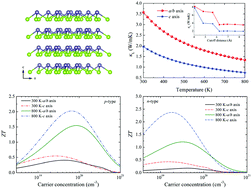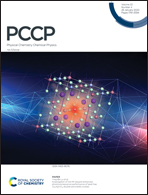A first-principles study of the thermoelectric properties of rhombohedral GeSe
Abstract
Manipulation of crystal symmetry is an important strategy to tune the thermoelectric performance. High-symmetry thermoelectric materials benefit from high band degeneracy. With first-principles calculations and Boltzmann transport theory, we systematically investigate the electronic and phononic transport properties of rhombohedral GeSe with higher symmetry. At optimized carrier concentrations, the maximum power factors are found to be 5.86 mW m−1 K−2 for the p-type and 4.45 mW m−1 K−2 for the n-type, respectively. The high p-type power factor originates from the highly degenerated L and Σ bands and small energy offset between them, while the n-type one results from the weak electron–phonon coupling. More importantly, rhombohedral GeSe possesses anisotropic and low lattice thermal conductivities of 3.58 W m−1 K−1 and 1.96 W m−1 K−1 at room temperature in the intralayer and interlayer directions, respectively, which is associated with the giant phonon anharmonicity driven by the resonant bonding. Combining the high power factor and low thermal conductivity, the predicted ZT values for p-type and n-type doping can reach 2.02 and 2.37 at 800 K. This study offers insights into the thermal and charge transport properties in rhombohedral GeSe, and demonstrates that both p-type and n-type GeSe are potential high-performance thermoelectric materials.

- This article is part of the themed collection: 2020 PCCP HOT Articles


 Please wait while we load your content...
Please wait while we load your content...